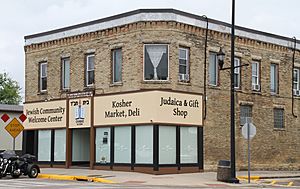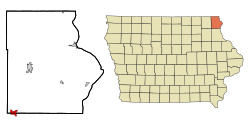Postville, Iowa facts for kids
Quick facts for kids
Postville, Iowa
|
|
|---|---|
 |
|
| Motto(s):
Hometown to the World
|
|

Location of Postville, Iowa
|
|
| Country | United States |
| State | Iowa |
| Counties | Allamakee, Clayton |
| Township | Post |
| Settled | June 1843 |
| Incorporated | March 11, 1873 |
| Area | |
| • Total | 2.08 sq mi (5.38 km2) |
| • Land | 2.08 sq mi (5.38 km2) |
| • Water | 0.00 sq mi (0.00 km2) |
| Elevation | 1,181 ft (360 m) |
| Population
(2020)
|
|
| • Total | 2,503 |
| • Density | 1,205.10/sq mi (465.29/km2) |
| Time zone | UTC-6 (Central (CST)) |
| • Summer (DST) | UTC-5 (CDT) |
| ZIP code |
52162
|
| Area code(s) | 563 |
| FIPS code | 19-64290 |
| GNIS feature ID | 0460373 |
Postville is a small village located in the state of Iowa, in the United States. It sits where four counties meet: Allamakee, Clayton, Winneshiek, and Fayette. The village is also at the crossroads of major roads like U.S. Routes 18 and 52.
In 2020, about 2,503 people lived in Postville. It's known for being a place where many different cultures live together.
Contents
History of Postville
Postville was officially planned out in 1853. It was named after Joel Post, who was one of the first people to settle there.
A Changing Community
In 1987, a group of Hasidic Jews started a large Kosher meat processing factory called Agriprocessors in Postville. This factory became very important for the village's economy.
Later, in 2008, the factory faced some challenges, including a government investigation. This led to the factory filing for bankruptcy. A new company, SHF Industries, bought the plant in 2009. It reopened under a new name, Agri Star, and continues to operate today. These changes brought new groups of people to Postville, making it a diverse community.
Geography and Climate
Postville covers an area of about 2.11 square miles (5.38 square kilometers), and all of it is land.
Weather in Postville
Postville experiences a wide range of weather throughout the year. Summers are generally warm, while winters can be very cold with snow. The village gets a good amount of rain, especially in the spring and summer months.
| Climate data for Postville, Iowa (1991–2020 normals, extremes 1897–present) | |||||||||||||
|---|---|---|---|---|---|---|---|---|---|---|---|---|---|
| Month | Jan | Feb | Mar | Apr | May | Jun | Jul | Aug | Sep | Oct | Nov | Dec | Year |
| Record high °F (°C) | 58 (14) |
66 (19) |
83 (28) |
88 (31) |
105 (41) |
104 (40) |
108 (42) |
102 (39) |
99 (37) |
89 (32) |
76 (24) |
64 (18) |
108 (42) |
| Mean daily maximum °F (°C) | 25.7 (−3.5) |
29.9 (−1.2) |
43.0 (6.1) |
57.5 (14.2) |
69.4 (20.8) |
79.0 (26.1) |
82.8 (28.2) |
80.8 (27.1) |
74.0 (23.3) |
60.6 (15.9) |
44.7 (7.1) |
31.4 (−0.3) |
56.6 (13.7) |
| Daily mean °F (°C) | 16.6 (−8.6) |
20.2 (−6.6) |
32.7 (0.4) |
45.8 (7.7) |
58.2 (14.6) |
68.4 (20.2) |
71.9 (22.2) |
69.5 (20.8) |
61.6 (16.4) |
48.8 (9.3) |
35.1 (1.7) |
22.7 (−5.2) |
46.0 (7.8) |
| Mean daily minimum °F (°C) | 7.4 (−13.7) |
10.5 (−11.9) |
22.4 (−5.3) |
34.0 (1.1) |
46.9 (8.3) |
57.8 (14.3) |
60.9 (16.1) |
58.2 (14.6) |
49.2 (9.6) |
37.0 (2.8) |
25.5 (−3.6) |
14.0 (−10.0) |
35.3 (1.8) |
| Record low °F (°C) | −35 (−37) |
−29 (−34) |
−18 (−28) |
6 (−14) |
20 (−7) |
34 (1) |
39 (4) |
35 (2) |
20 (−7) |
−7 (−22) |
−12 (−24) |
−27 (−33) |
−35 (−37) |
| Average precipitation inches (mm) | 1.12 (28) |
1.21 (31) |
2.09 (53) |
4.14 (105) |
4.99 (127) |
5.88 (149) |
4.52 (115) |
4.36 (111) |
3.96 (101) |
3.00 (76) |
2.10 (53) |
1.57 (40) |
38.94 (989) |
| Average snowfall inches (cm) | 12.0 (30) |
10.4 (26) |
5.0 (13) |
1.6 (4.1) |
0.0 (0.0) |
0.0 (0.0) |
0.0 (0.0) |
0.0 (0.0) |
0.0 (0.0) |
0.1 (0.25) |
2.7 (6.9) |
8.0 (20) |
39.8 (101) |
| Average precipitation days (≥ 0.01 in) | 5.8 | 5.4 | 6.7 | 10.1 | 12.2 | 11.2 | 8.8 | 9.0 | 8.5 | 7.7 | 5.9 | 6.1 | 97.4 |
| Average snowy days (≥ 0.1 in) | 5.2 | 4.5 | 2.6 | 0.9 | 0.0 | 0.0 | 0.0 | 0.0 | 0.0 | 0.2 | 1.6 | 4.5 | 19.5 |
| Source: NOAA | |||||||||||||
Population and People
Postville has seen its population grow over the years. In 2000, there were 2,273 people, and by 2020, it had grown to 2,503.
| Historical populations | ||
|---|---|---|
| Year | Pop. | ±% |
| 1880 | 732 | — |
| 1890 | 884 | +20.8% |
| 1900 | 984 | +11.3% |
| 1910 | 952 | −3.3% |
| 1920 | 1,039 | +9.1% |
| 1930 | 1,060 | +2.0% |
| 1940 | 1,194 | +12.6% |
| 1950 | 1,343 | +12.5% |
| 1960 | 1,554 | +15.7% |
| 1970 | 1,546 | −0.5% |
| 1980 | 1,475 | −4.6% |
| 1990 | 1,472 | −0.2% |
| 2000 | 2,273 | +54.4% |
| 2010 | 2,227 | −2.0% |
| 2020 | 2,503 | +12.4% |
| Source: and Iowa Data Center Source: |
||
A Diverse Community
Postville is known for its diverse population. While many towns in Iowa are mostly made up of one ethnic group, Postville has welcomed people from many different backgrounds.
- Jewish Community: A group of Orthodox Jews moved to Postville to start the Agriprocessors factory. At one point, there were about 100 Orthodox Jewish families living there. Even today, Postville has services for Jewish families, including a Jewish elementary school and a yeshiva (a Jewish school for religious studies).
- New Immigrants: Over time, people from Latin America and Somalia have also moved to Postville. Many of them work at the local factories. This mix of cultures has made Postville a unique place in Iowa.
Economy and Jobs
Postville's economy is largely supported by its factories.
Meat Processing Plants
The Agri Star Meat & Poultry, LLC plant is a major employer in Postville. It is a kosher meat plant, meaning it prepares meat according to Jewish dietary laws. As of 2017, about 700 people worked there.
Another important factory is Norplex-Micarta. This factory, started in 1975, makes special plastic materials called laminated plastics. These materials are used in many different products. In 2007, Norplex-Micarta employed between 150 and 200 workers.
Education in Postville
The Postville Community School District runs the public schools in the village. Students attend John R. Mott High School for their high school education.
For students who wish to pursue Jewish religious studies, there is also the Mesivta of Postville, which is a yeshiva.
Famous People from Postville
Some notable people have connections to Postville:
- William Michael McKinley (1879–1964) was raised in Postville. He later became a speaker in the Illinois House of Representatives.
- John R. Mott (1865–1955) lived in Postville as a child. He won the Nobel Peace Prize in 1946 for his work promoting peace.
- Brett Szabo (born 1968), a former NBA player, also lived in Postville when he was young.
Books About Postville
The unique story of Postville and its diverse community has been written about in several books:
- Postville: A Clash of Cultures in Heartland America by Stephen G. Bloom explores how long-time residents interacted with newcomers.
- Postville USA: Surviving Diversity in Small-Town America by Mark Grey, Michele Devlin, and Aaron Goldsmith looks at the community's experiences with diversity.
Images for kids
See also
 In Spanish: Postville (Iowa) para niños
In Spanish: Postville (Iowa) para niños


